Credits: Biovision-Infonet
Introduction
A breed is a race or variety related by descent and similarity in certain distinguishable characteristics. More than 250 breeds of cattle are recognized throughout the World. In Africa there are two main races of Cattle: Bos indicus (cattle with humps) including the Boran, Sahiwal and Zebu cows (indigenous) and the Bos taurus (exotic or imported breeds). The two races can cross breed, and the crosses can be very productive both in terms of growth rates for beef, improved milk production as well as disease resistance.
Kenya has the highest number of exotic dairy cattle. As for indigenous breeds, Kenya also ranks high with Ethiopia and Sudan topping the list of African countries with the highest population of indigenous cattle breeds.
Some agro-ecological zones (AEZ’s) are not suitable for pure breed high yielding milk cows, but can benefit from crossbreeding the local breeds of cattle with exotic breeds. However, this will only be useful if management practices such as improved feeding, plenty of fresh water available, and a reliable source of veterinary drugs are available. Without these conditions the survival rate of exotic breeds and cross breeds is likely to be low. This should be one of the first things to consider in a breeding plan: what animal breed fits best to the circumstances on the farm.
Whether indigenous breeds or exotic breeds or crossbreeds will perform best depend amongst others on the climate, the occurring diseases, the available feed resources and the availability of fresh water.
Exotic breeds are more expensive to buy and require more sophisticated housing facilities. The indigenous breeds are in general more hardy and used to the circumstances, less sensible for diseases and less demanding for quality feed. The production is low, but in most farms the potential is not fully used. Under sub-optimal conditions the indigenous breeds stay healthy and animal welfare is less at risk as with exotic breeds in the same situation. Although production is low, it might be more economically profitable to have indigenous breeds instead of exotic breeds because the needs in feed and healthcare are lower. Breeding possibilities in isolated areas are less than in areas with good infrastructure. Use of local breeding bulls instead of artificial insemination could be a limiting factor in improving the production of local cattle. Working together as farmers group and take initiatives as a group could be advantageous.
Milk Breeds
a) Friesian breed
The exact origins of the breed are difficult to determine but it is known that in the 18th century, herds of small black-and-white cattle were brought into northern Holland and Friesland from northern Jutland to replace animals that had fallen victim to disease and flooding. These animals were crossed with the existing Dutch cattle and formed the basis of the Friesian.
Before the establishment of the Netherlands herd book in 1873 and the Friesland herd book in 1879, both black-pied and red-pied animals were maintained separately. The preference for black-pied cattle, particularly in the United States, led to the further segregation of red-pied animals and presently this colour variation only exists in small number in the Netherlands.
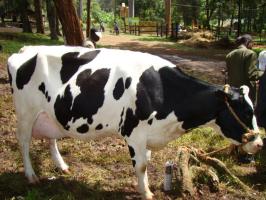

(c) AIC Documentation Unit, Kenya
Production levels of this breed declined during the 1950’s when excessive emphasis was placed on correct colour pattern. During the 1970’s Holsteins were imported from the United States and used to improve the milk production. This resulted in larger animals with a more pronounced dairy characteristics. The mixing of these two breeds is such that now many Friesians are 25% to 75% Holstein.
The modern Friesian is pre-eminently a grazing animal, well able to sustain itself over much lactation, on both low lying and upland grassland, being developed by selective breeding over the last 100 years. Some outstanding examples of the breed have 12 to 15 lactations to their credit, emphasizing their inherent natural fecundity. In response to demand, protein percentages have been raised across the breed and herd protein levels of 3.4% to 3.5% are not uncommon.
Typical characteristics include:
Purpose: Milk production
Potential yield: 40-50 litres milk/day, 3,2% butter fat.
Average body size: Large (550-650 kg)
Description: Black and white short haired coat, short horns
Advantages:
- High milk production potential with low butter fat content of about 3.2%
- Note: Milk production will depend on level of feeding and other management. Heifers generally come into milk at about two years of age.
- Suitable for zero grazing
- Frequent calving in their lifetime, longevity, so need less replacements
- Provide valuable male calves
- Have lower cell counts
- They are known for their versatility: they provide high quality milk and high quality lean meat
Disadvantages:
- Heavy feeder
- Need high level management
- Susceptible to diseases, susceptible to milk fever
- Susceptible to high temperatures
- Feed requirements high (90-110 kg fresh forage/day i.e. 3 gunny bags)
- Adequate clean water (min 60 lts/day, more for heavy yielders)
Friesians and their crossbreeds are predominant in Kenya particularly in Central Kenya and Central Rift Valley.
The farms where they can be found include:
1. Manera (Delamere Estates), Naivasha
2. KARI Naivasha, PO Box 25 Naivasha
3. KAR Lanet, PO Box 1275, Nakuru
4. Agricultural Development Corporation (ADC) Katuke Complex, PO Box 1392-30200 Kitale
5. Makongi Farm, PO Box 1320-30100 Eldoret
6. Kisima Farm, PO Box 19- 20107 Njoro
7. Gogar Farm PO Box 6-201080 Rongai
8. University of Nairobi Farm PO Box 29053-10202 Kabete
9. Sanctuary Farm PO Box 244-20177 Naivasha
10. Marimba Farm PO Box 32 Meru
11. ADC Olngatongo PO Box 680-30200 Kitale
12. Gicheha Farm, PO Box 236 Ruiru
b) Ayrshire breed
The Ayrshire breed originated from the county of Ayr in Scotland, prior to 1800. The breed was introduced to Kenya in 1908 from South Africa. It has been developed over the last century through inputs of bloodlines from Britain, South Africa, Sweden, New-Zealand, Canada and USA.
Kenya Aryshire cattle breeders emphasize on medium cow balanced for type, production, longer life and fertility. Ayrshire population in Kenya is estimated to be over 1.2 million of which nearly 30’000 are registered.

(c) AIC Documentation Unit, Kenya
Typical characteristics include:
Purpose: Milk production. Ayrshire milk is referred as “the ideal drinking milk”; it is not excessively rich, not lacking adequate fat, and it possesses desirable quantities of proteins.
Potential yield: 30 litres/day, 4,7% butter fat, depending on feeding and management.
Average yield: 10 litres/day
Average body size: Large (average live-weight 450 kg)
Description:
- Body colour: Brown and white patches in almost equal amounts with some cows tending to dark mahogany colour
- Prominent strongly attached and balanced udders
- Strong loins, long stooping from hip to pin bones
- Good spring of ribs and deep body capacity
Advantages:
- High milk production potential (30 litres/day). The average milk yield from this breed in Kenya is roughly 3000 litres in 305 days with butter fat of 4.7%. Heifers generally come into milk at about two years of age.
- Fairly hardy and adaptable to varied agro-ecological zones (AEZs)
- They are easy calving
- They are relatively resistant to diseases and free of genetic diseases
- Better suited to range management than the Fresian breed
Disadvantages:
- Feed requirements high (90-110 kg fresh forage/day i.e. 3 gunny bags)
- Need plenty of clean water (60 litres/day)
Farms keeping Ayrshire in Kenya (officially registered):
1. Agricultural Development Corporation (ADC) Katuke Complex, PO Box 1392-30200 Kitale
2. Makongi Farm, PO Box 1320-30100 Eldoret
3. Kisima Farm, PO Box 19- 20107 Njoro
4. Gogar Farm PO Box 6-201080 Rongai
5. ADC Lanet Farm PO B0x 1124-20100 Nakuru
6. University of Nairobi Farm PO Box 29053-10202 Kabete
7. Moi University Farm PO Box 30900-30100 Eldoret
8. Loruk Farm PO Box 104-10400 Nanyuki
9. Waunyomu Ngeke Ranch PO Box 236-00232 Ruiru
10. Sanctury Farm PO Box 244-20177 Naivasha
11. Marimba Farm PO Box 32 Meru
12. KARI Ol Joro Orok Private Bag 20302 Ol Joro Orok
13. ADC Olngatongo PO Box 680-30200 Kitale
14. Sunset Farm PO Box 13366-20100 Nakuru
15. Limuru Agricultural Youth Centre PO Box 30496 Nairobi
16. Chemusian Farm PO Box 86-20107 Menengai
c) Guernsey breed
The Guernsey originated on the small Isle of Guernsey, situated in the English Channel just off the coast of France. There is no concrete evidence as to the development of the Guernsey before the 19th Century but there may be some truth in the theory that the Isigny cattle of Normandy and the Froment du Leon breed from Brittany were ancestral relatives of the modern Guernsey.

(c) J.O.Ouda, KARI, Kenya
Purpose: Milk production. Heifers generally come into milk at about two years of age.
Potential yield: 25 litres/day and 4.3% butter fat.
Average body size: Medium (average live-weight 475 kg).
The bull weighs 600 to 700 kg. The average weaning weight of heifers and bull calves is 75 kg.
Description:
1. The colour of the Guernsey varies from yellow to reddish-brown with white patches.
2. They have a finely tuned temperament, not nervous or irritable.
3. Physically the breed has good dairy conformation and presents the visual impression of a plain animal bred for utility rather than good looks.
4. They have an attractive carriage with a graceful walk, a strong back, broad loin, wide rump and deep barrel, strong, attached udder extending well forward, with the quarters evenly balanced and symmetrical.
5. The Guernsey bull has an attractive individuality, revealing ample vigour and masculinity. It has smooth-blending shoulders showing good refinement, strength and even contour.

(c) J.O.Ouda, KARI, Kenya
Advantages:
1. High milk production potential (25 lts/day) with moderate butter fat content 4.3%.
2. Feed requirements: Moderate (65-85 kg fresh forage/day i.e. 2 gunny bags)
3. Guernsey are efficient converters of feed to product, being of intermediate size, Guernsey produce their high quality milk while consuming 20 to 30 percent less feed per pound of milk produced than larger dairy breeds.
4. Guernsey reach reproductive maturity at an early age and can calve at 22 months of age. This provides an early return on investment.
5. Guernsey produce calves big at birth, which are easy to rear.
6. Guernsey are well known for having the minimum of calving complications.
7. Guernsey are adaptable to all climates and management systems and lack any known undesirable genetic recessives.
8. Her fawn and white coat enhances her heat tolerance and reduces heat stress, which adds to her ability to maintain production levels anywhere.
9. They are docile and have an ideal Dairy Temperament.
Disadvantages:
1. Need plenty of clean water (40 lts/day)
Farms keeping Guernsey in Kenya (options):
1. Egerton University, PO Box 356, Njoro
2. ADC Lanet Farm PO B0x 1124-20100 Nakuru
3. ADC Olngatongo PO Box 680-30200 Kitale
4. Gicheha Farm, PO Box 236 Ruiru
d) Jersey breed
Despite considerable research, nothing definite is known as to the actual origin of the cattle first brought to Jersey Island. Most research agrees that the Jersey probably originated from the adjacent coast of France, where in Normaaling Jerseys are found.
Purpose: Milk production.
Average yield: 22 litres/day and 6.3% butter fat.
Average body size: Small – medium (350 Kg)
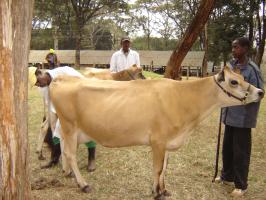
(c) AIC Documentation Unit, Kenya
Description:
1. Jerseys in Kenya are typically light brown in colour, though this can range from being almost grey to dull black. They can also have white patches which may cover much of the animal. A true Jersey will however always have a black nose bordered by an almost white muzzle.
2. They have protruding eyes.
3. This breed is well known for milk with high quality – it is particularly richer in fat, protein, minerals and trace elements than those from the larger dairy breeds. The milk is also rich in colour which is naturally produced from carotene.
4. Milk production potential is moderate (20 lts/day), depending on feeding and management regime.
Advantages:
1. Feed requirements is relatively low (65-85 kg fresh forage/day i.e. 2 gunny bags).
2. Milk has high butter fat content 5.2%.
3. It is hardy and adaptable to varied AEZs.
4. The Jersey’s hard black feet are much less prone to lameness.
5. They perform well under a wide range of systems and are well-known for their high feed conversion efficiency.
6. Jerseys generally produce milk components at a lower cost compared to the other major breeds.
7. They stay in the herd longer than any other dairy breed. Her milk has greater nutritional value, plus the highest yield and greater efficiency when processed into cheese and other value-added products.
8. The breed has little or no calving problems, greater fertility, a shorter calving interval, and earlier maturity.
9. Also suitable for cross breeding/ improving local breeds.
Disadvantages:
1. Susceptible to milk fever and tick borne diseases
A few contacts/farms where Jersey can be found in Kenya are:
1. OlEndeti (Grammaticas) Nairobi, Tel-2067686
2. Ololua Farm (Carol Rees) PO Box 21007 Nairobi, Tel-891015
3. Ontulele (Biddy Davis) Nairobi Tel-891518)
4. Ol Donyo (Tara Llewelyn) PO Box 111 Nanyuki
5. Rawhide (Janet Mills) Nakuru 051-343005
6. ADC Sabwani Complex, PO Box 680 Kitale
Dual Purpose Breeds
a) Simmental / Fleckvieh

(c) Mette Vaarst
Purpose: Meat and milk production
Average body size: Large (average live-weight 750 kg)
Description: Body color brown and white or black and white
Advantages:
1. High production potential with good management and good feeding
Disadvantages:
- Susceptible to tick borne diseases.
- Only suitable for cool areas with year round quality fodder availability.
- Potential milk yield: low to moderate (10-15 liters/day).
- High forage requirement
b) Boran breed
By careful selection and application of the strict standards of excellence of the Boran Cattle breeders Society, the Boran breed has been developed into an ideal beef animal suitable for the arid range areas to be found in many parts of the world. The original strains of the breed came from Ethiopia and were adopted early in the 20th Century by commercial cattlemen in Laikipia, Machakos and the Rift Valley Districts of Kenya. The Boran society was formed in 1951 and its panel of inspectors continues to ensure that the breed progresses and keeps up to date with the demands of modern beef production. The society promotes exports of embryos world wide and semen is exported throughout the East African region.
Purpose: Meat and milk production
Average body size: Medium (Average live-weight is 350-400 kg)

(c) AIC Documentation Unit, Kenya
Description:
The Boran is typically white in colour with dark points and pigmented generally black skin. Steel-grey with black points is not uncommon. Fawn and red also occur, but black is rare and is not considered a true Boran colour. The Breed standard permits all colours except brindle.The head is carried well, of medium length and slightly convex. Ears are small in comparison with the Indian breeds and not pendulous. Horns are generally short, round in cross- section and upright, but there is some variation in size and length. Polled animals are not uncommon and some animals have been selected for this condition.The hump is well defined and thoracic; it is larger in the male than in the female. The Boran shows a surprisingly straight top line for a Zebu animal. The well-developed hindquarters have frequently been remarked upon. The rump is long, wide and muscular in the male and the buttocks are well fleshed. Among Zebu breeds the Boran is outstanding in this character.
Skin is generally thin, with loose folds and pliable. Both the dewlap and umbilical folds are well developed.The Boran is generally vigorous and alert. Being accustomed to desert condition, it covers vast distances in search of grazing and water and in some areas is only watered on alternate days or on the third day.
Fertility
Boran produce a calf a year. Even under harsh conditions the Boran cow will continue to breed and rear calves and do this without punishing herself. One explanation for this high fertility is that the cow has relatively low body weight loss over the suckling period, thereby maintaining a good condition, thus able to conceive again.
Longevity
Boran cattle live a long time. It is quite normal for 15 years old breeding cows to be sound mouthed and it is also on record that a 16 year old Boran bull is still producing high quality semen for artificial insemination.
Temperament
Boran cattle are recognized as being generally quiet, docile and easy to handle. This trait has developed over many generations of cattle living close to man.
Beef production and Carcass Quality
Average weight gains per day on grass & feedlot: Grass = 0.7 – 1.0 kg depending on grass quality. Feedlot = 1.3 kg per day depending on type of cross used (this was found at a recent trial at Marania Farm – Timau where using Boran cross Angus steers & heifers). Trials in Nebraska, USA, show that the Boran and its crosses score consistently better than other Zebu breeds for meat tenderness, carcass marbling and rib eye area. Butchers in Kenya prefer Borans and their crosses for this reason.
Disease Resistance
The Boran has a useful degree of host resistance to ticks and it is reported that the breed is ‘completely resistant to buffalo fly’. Borans are generally less affected by foot and mouth diseases than exotics and recover faster. It is also clear that the morbidity and mortality rates of East Cost Fever are lower in Boran than in Boss taurus breeds; the Boran being naturally more resistant.
Survival Characteristics
Being an animals which in obliged to walk long distances, selection for perfect feet and leg conformation is necessary for registered cattle.
The herd instinct of the Boran makes it very easy to manage in bush country. They are noted for being able to ‘graze on the trot’ and they will always stay together.
The cow has a well-carried udder with strong attachments and neat, small teats. Boran heifers reach puberty at an average age of 13 months. She is an excellent mother, not only will she feed her calf so well that high weaning weights are attainable, but she guards against predators, and will never allow her calf to get lost in the bush. Calving problems hardly exist. Calves at birth weigh an average of 28 kg for males and females, 25 kg.
Boran cattle have developed adaptive traits of crucial importance for their survival. Some of these characters are – the ability to withstand periodic shortage of water and feed, ability to walk long distances in search of water and feed and ability to digest low quality feeds.
The well-developed beef conformation shows up in carcass appraisals. The depth of eye muscle, marbling, even fat cover and ratio of hind to forequarter make the Boran difficult to beat, hence the preference of Kenya butchers for young, well-finished Boran steers.
Advantages:
1. Docile
2. Milk has high butter-fat of 4.8%
3. Good breeds for marginal areas
Disadvantages:
1. Milk production potential is low (10 liters/day)
2. Difficult breeders, most mating at night
c) Sahiwal breed
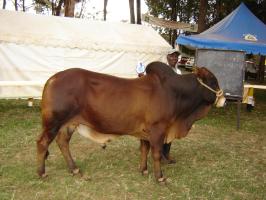
(c) AIC Documentation Unit, Kenya
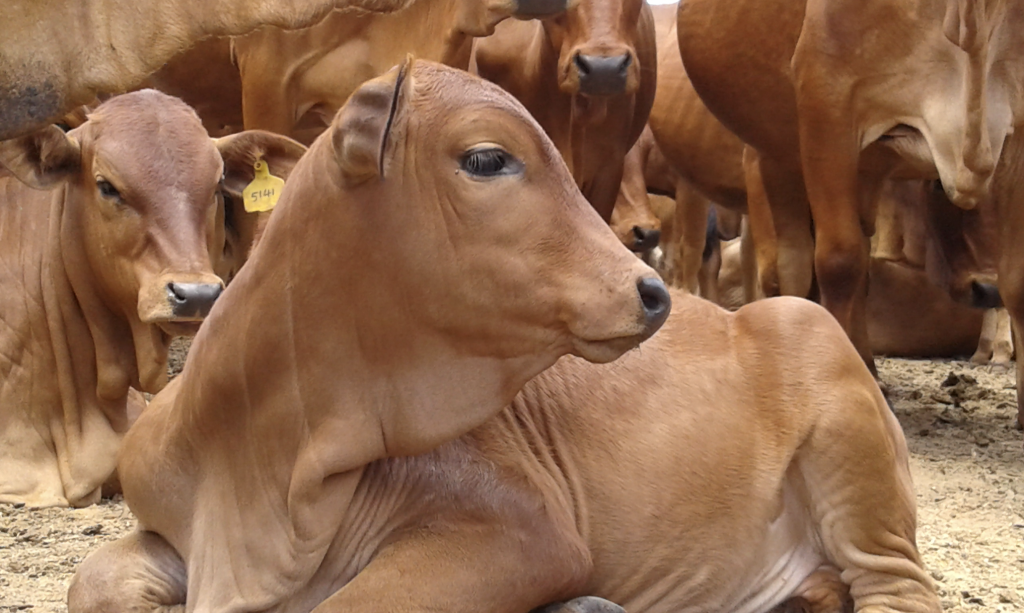
This Zebu breed originates from India and Pakistan. National study was established in 1963 in Naivasha with the purpose of improving the breed for milk and beef i.e. as dual purpose breed. For a long time the breed was confined to government farms where the focus was conservation, characterization, improvement and utilization in smallholder systems. This breed is adapted to utilization of of poor quality pasture and rough terrain.
Purpose: Meat and milk production
The milk yield is highly variable because of variation of management regimes. Yields may range from 5-10 litres/day
Average body size: Large (average live-weight 350-400 kg)
Description: Body colour is solid brown
Advantages:
1. Docile.
2. Good breeds for marginal areas.
3. Milk has high butter-fat of 4.8%
Disadvantages:
1. Milk production potential is low (10 Kg/day)
2. Difficult breeders, most mating at night
Farms where they can be found include:
The largest herds in Kenya are kept by KARI, Naivasha and El-Karama Nanyuki.
d) East African Zebu

(c) Anne Bruntse, Biovision
Purpose: Milk and meat production
Average body size: small (average live-weight 250-300 kg)
Description: Body colour is variable, the breed has a prominent hump
Advantages:
1. Very hardy and disease resistant animal
Disadvantages:
1. Milk production potential is low (5 liters/day)
2. Late maturing (3 years)
ANKOLE
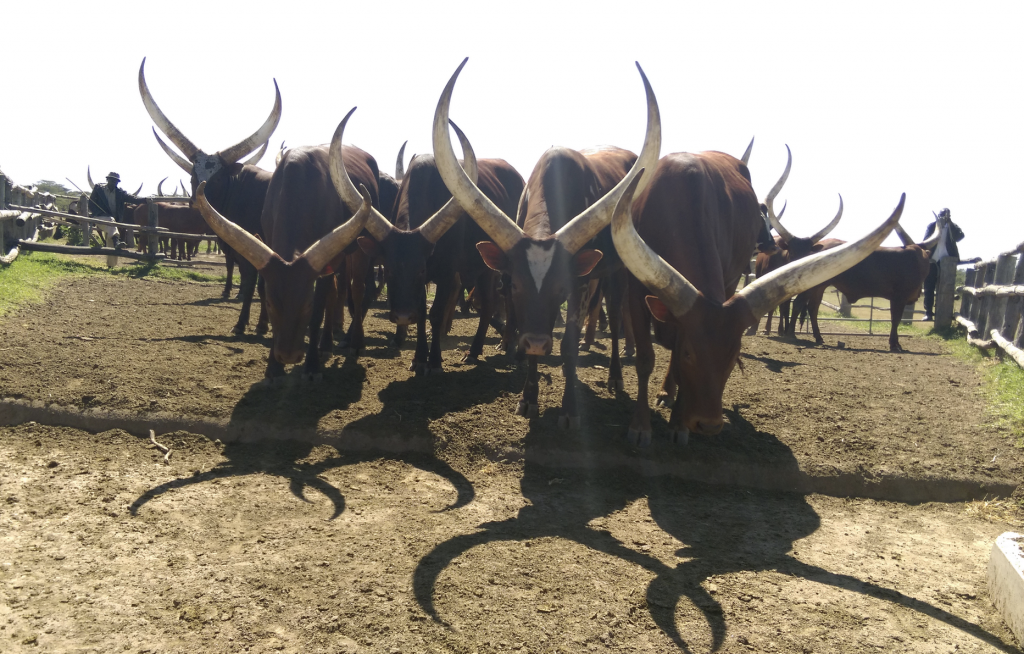
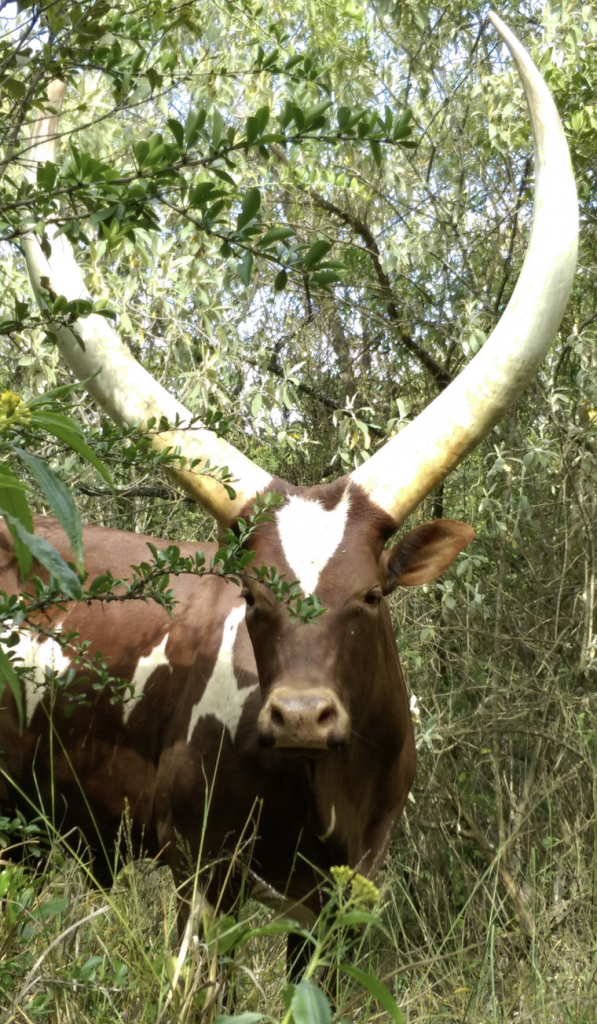
Purpose: Milk and meat production
Average body size: small (average live-weight 350-700 kg)
Description: Body colour is brown red , or speckled white on brown red base
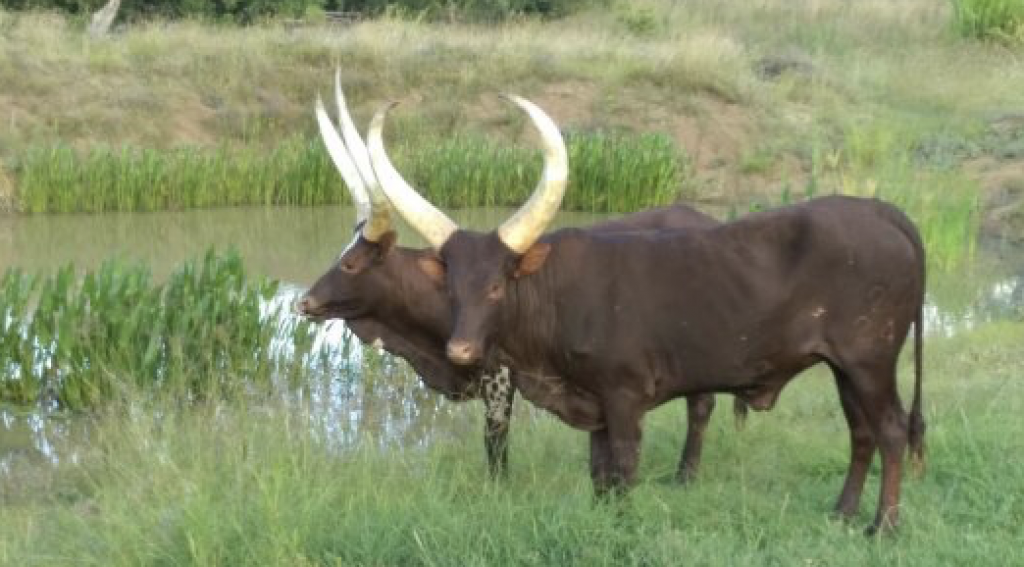
Advantages:
1. Very hardy and disease resistant animal
2. High quality milk
3. Low cholesterol meat
4. Formidable parenting
5. Great calving ease, small calves
Disadvantages:
1. Milk production potential is low (5 liters/day)
2. Late maturing (2 years)
Beef Breeds:
Hereford

(c) Anne Bruntse, Biovision
Purpose: Meat production
Average body size: Large (average live-weight 550 kg)
Description: Body color reddish brown body with white head and feet
Advantages:
1. Good beef conformation for the discerning consumer.
Disadvantages:
1. High forage requirement
2. As all exotic breeds Hereford is susceptible to tick borne diseases.
3. Only suitable for cool areas with year round quality fodder availability.
Charolais

(c) Anne Bruntse, Biovision
Purpose: Meat production
Average body size: Large (average live-weight 800 kg)
Description: Body color white
Advantages:
1. High production potential with good management and good feeding.
2. Good beef conformation for the discerning consumer.
Disadvantages:
1. Susceptible to tick borne diseases.
2. Only suitable for cool areas with year round quality fodder availability.